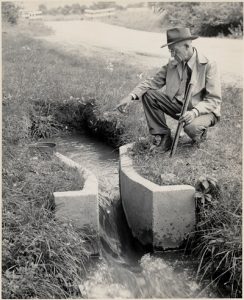 Farmers could tap into reliable information at Colorado Agricultural College (CAC) in Fort Collins. Founded in 1870 and now known as Colorado State University, the land-grant college researched and disseminated hydrologic information to rural people.
Farmers could tap into reliable information at Colorado Agricultural College (CAC) in Fort Collins. Founded in 1870 and now known as Colorado State University, the land-grant college researched and disseminated hydrologic information to rural people.
State experts made a significant contribution to the accurate measurement of river flow. The first State Engineer, in 1881, installed a staff gauge at the mouth of the Poudre Canyon and took measurements of the flows that he provided to water commissioners. In 1883 E.S. Nettleton, the second State Engineer, installed a permanent gauging station with a serial self-recording device.
One of CAC’s first civil and irrigation engineering students, Ralph Parshall, returned in 1907 as a professor. Later employed by the U. S. Department of Agriculture, working in partnership with the college and using the college’s hydraulics laboratory, he developed the measuring flume that bears his name. The Parshall Flume was precise, inexpensive, and easy to use and remains one of the world’s most popular water-measuring devices.
The momentum of technical water studies carried into the non-academic world as well. B.S. La Grange, the first water commissioner on the Poudre, theorized that irrigation water soaks into the ground, eventually flowing back into the river. His experiments were the first “return flow” measurements in the United States.
By 1900, a new crop appeared and reshaped northern Colorado. Initially, farmers were reluctant to grow sugar beet seeds. Still, the potential was tempting, as experts touted the beets thriving on long hours of sunlight, low humidity, steady amounts of moisture, and good soil, all available in northern Colorado.
The sugar beets flourished. Between 1901 and 1906, sugar factories sprang up in Fort Collins, Greeley, Windsor, and Eaton. These factories used water to convert beets into commercial sugar. Colorado was the largest sugar beet producer in the country.



